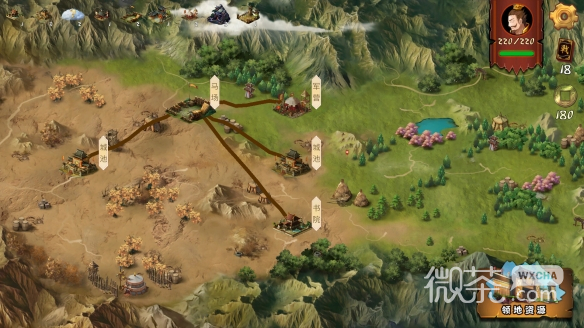Many students in the Return of the Three Kingdoms still don’t know the gameplay guide for the various factions of Wei, Shu, and Wu in the Return of the Three Kingdoms. The following is the "Overview of the gameplay guides of the various factions of Wei, Shu, and Wu in the Return of the Three Kingdoms" edited by the editor of Source Code.com. Players who have these questions should take a look. Well, it might help everyone.
All cards are divided into four categories: "General", "Formation", "Army" and "Spell". "Army" is further divided into three categories: "Infantry", "Cavalry" and "Archer". Handheld cards can be divided into categories: strike, defense, and gain. The overall number of debuff cards given by the enemy is not large.
The three forces of Shu, Wei and Wu have different "General" cards, "Army" cards that are mostly the same but partially different, as well as common "Formation" cards and "Spell" cards.
The "General Card" determines what type of fighting style each force is suitable to use. The three forces of Shu, Wei and Wu represent three different fighting styles. Here, we can review the "self-harm flow", "infinite flow", "card passing flow", "rebound flow" and other genres in Slay the Spire through card type combinations.
There are also relics (treasures) in the game, but there are no pure-buffs.
Unlike Slay the Spire, the cards in the game have no upgrade settings except for "Guan Yu".
The representative school of Shu: Yidao style (that is, the power style)
Core cards: Liu Bei (+command value), Guan Yu (5 points of damage), Shuguang (cooling down of all generals -3), Taoyuan Friendship (the cost of the next general card is 0), Unparalleled General (the next general card is played twice)
Key treasure: Sundial (after the general kills the enemy, everyone cools down to the initial state)
This genre only practices one "Guan Yu". The characteristics of "Guan Yu" are high cost and high damage. Every time you use this card to kill an enemy, the card's damage value +1. What is different from "Slay the Spire" is that as long as you have enough command value and are in the skill cooldown state, you can draw "General Cards" at any time, which ensures that you can practice them in every battle.
When I end the battle with Shu forces, the damage value of "Guan Yu" is usually not less than 130 (the enemy's health value in this game is only 1000 at most, add a few BUFFs, and it's nothing to hit 400 or 500 in one round).

The characteristic of this genre is that it is simple and crude. In addition, after passing the level once, you can choose to increase the initial hit of "Guan Yu" by 15 or 20 by assigning points. It is basically a no-brainer.
Another school in Shu is the self-mutilation style.
The core card is: Zhang Fei (for every 1 point of damage received, 1 point of anger is gained, for every 10 points of life lost, anger is gained +30%). This style requires activating "Zhang Fei" twice to convert anger into 1 point. :1 attack power, high-energy reverse output, relatively easy to lose.
Wei represents the school: "drawing cards, passing cards, unlimited flow"
Core cards: Cao Cao (discard 2 cards, draw 2 cards), Dian Wei (for every 2 cards drawn this round, gain 1 command point.
General: Whenever you gain 1 point of command value, draw 2 cards), Reinforcement (draw 1 army card from the draw pile), Regroup (draw 2 army cards from the discard pile), Light Cavalry (get 1 point of command value) , draw a card), Qingzhou Light Cavalry (draw a card, get command value equal to the cost of the card) and the very critical "Tiger Position" (cannot be played, discarding the card is +20 defense, and deals damage to all enemies Causes 10 points of damage)
Key Treasure: Sundial
Playing with the Wei Kingdom means constantly checking cards, similar to the assassin's gameplay in "Slay the Spire". During the card checking, damage and poison are used, and unlimited flow is created through card organization. The important point here is that "Dian Wei" is not an initial selectable general and must be cleared at least once before it can be used. Using "Xiahou Dun" at the beginning is high-cost and high-output, and the cost of "Xiahou Dun" needs to be drawn by "Cao Cao". If it is lowered, it is not as good as "Dian Wei" to show the true meaning of the passing flow from the beginning.
Wu’s representative style: combo style
Core cards: Sun Jian (2 combo points), mercenary cavalry, mercenary infantry, mercenary archers
Key Treasure: Sundial
This genre is an innovation of Three Kingdoms Return. If used well, it is also an unlimited flow of play. The playing method is very simple. Use 0-cost cards and low-cost cards to construct the selected card type in each round to obtain combo points, and then use each general card with combo points to implement strikes or gains.
I believe that after reading this guide on how to play the various factions of Wei, Shu and Wu in "The Return of the Three Kingdoms", all users will be suddenly enlightened. In fact, it is not difficult to play the game of "The Return of the Three Kingdoms". If you want to become stronger, please pay more attention to us. Let's You will become a master of the game step by step.